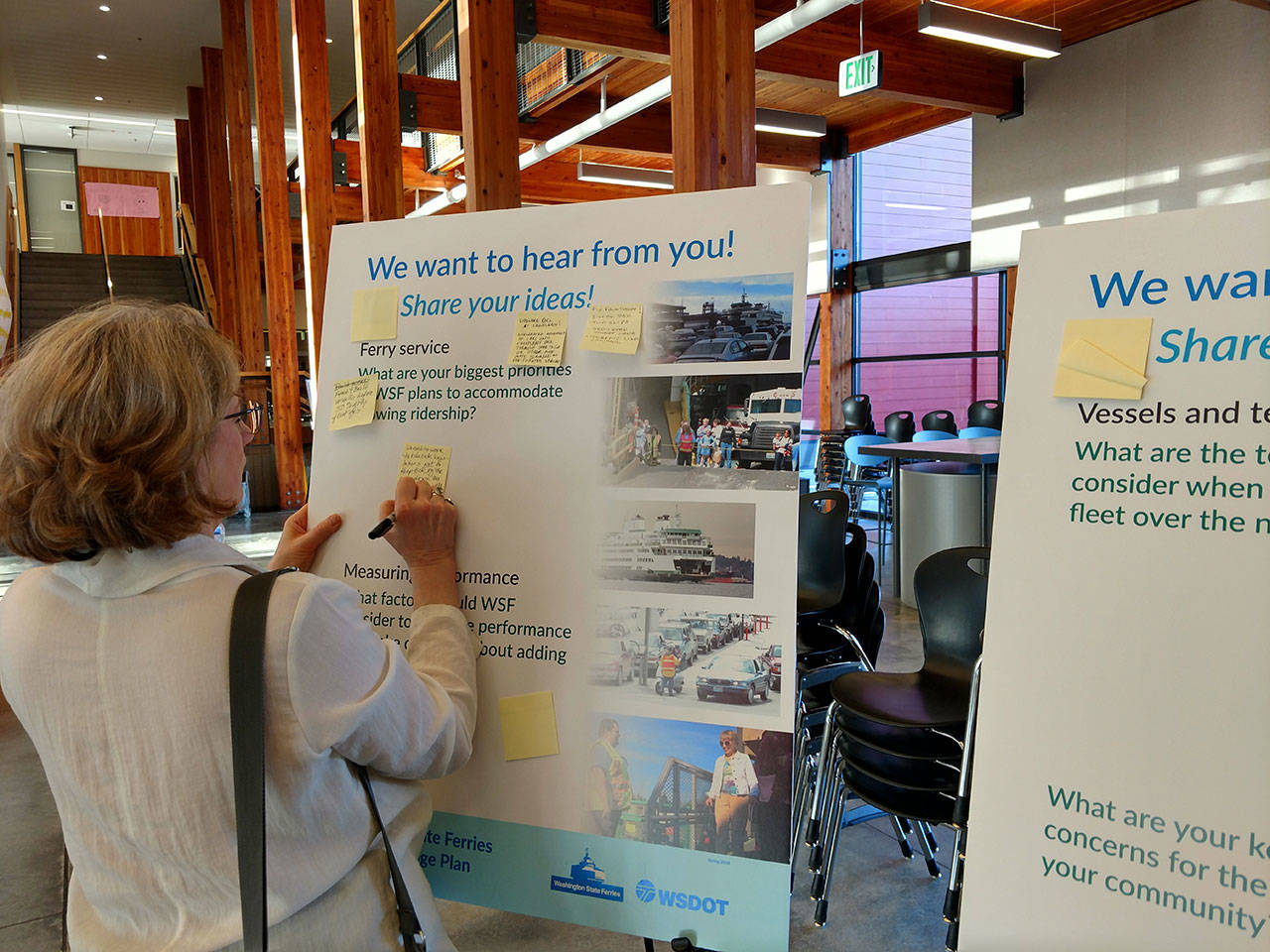Washington State Ferries hosted an open house last week on Vashon, where the information provided showed that some of the largest challenges in the next 20 years include managing increased demand, contending with a high number of aging vessels that will need to be replaced and “greening” the fleet.
About 25 people attended the event, which met at Vashon High School. Rather than deliver a presentation, ferry officials had set up several information boards and solicited public comment regarding what islanders feel is important for Ferries to consider as it drafts its long-range plan, which extends to 2040. Comments are being accepted online until May 24 at a website that includes the information provided at the meeting and a survey. WSF spokeswoman Hadley Rodero stressed that Ferries wants to hear from people.
“We want to see what people think, what issues they are concerned about and suggestions they have,” she said. “We will use the themes from survey results to help guide the plan.”
WSF projects that system-wide, ridership will grow by 30 percent by 2040. On the triangle route, WSF is projecting a substantial increase in ridership, including a 57 percent jump between Vashon and Southworth, a 37 percent increase between Fauntleroy and Southworth and 19 percent rise between Vashon and Fauntleroy. Similarly, the south end is predicted to see a 47 percent increase in riders.
Against the backdrop of a growing region and increased ridership, WSF is contending with an aging fleet. In fact, their materials show that 13 of their 23 vessels will need to be retired between now and 2040.
Rodero said that in the last 10 years, WSF has built seven boats. The last of the vessels and the fourth of the Olympic-class boats, which carry 144 vehicles, is under construction now and scheduled to go into service on the Mukilteo-Clinton route in September. There are no more boats scheduled to be built, nor is there funding in place for more, she said.
This issue has the attention of both Greg Beardsley, who heads the Vashon Ferry Advisory Committee, and Kari Ulatoski, who is a member of that committee and serves on the Triangle Route Improvement Task Force. Making it particularly urgent, they say, is that the boats are expected to last 60 years, beyond what many experts considerable reasonable. It is an issue that may be up for discussion as part of this long-range planning process. But with no boats in the pipeline, Beardsley and Ulatoski see hard times ahead.
“They are going to have to last until they are past 60,” Beardsley said. “That is just not reasonable. I do not care how good the engineers are with bailing wire.”
Ulatoski expressed her concerns about the aging vessels and the lack of back-up boats to fill in for vessels that need repairs. She added that it can decade a to design, fund and build boats — meaning new vessels may be a long time in coming.
“It is worse than it has ever been,” she said.
She added that she has concerns about the summer months, when ferry traffic is high.
“It is going to be ugly this summer and going forward because of no back-up boats,” she said.
New boats that will be planned will need to be more environmentally friendly than the current fleet. Ferry documents show that different propulsion systems would cut fuel use from 16 percent to 100 percent.
Earlier this year, Gov. Jay Inslee issued an executive order directing WSF to begin transitioning to a zero-carbon-emission ferry fleet. An additional executive order requires WSF to explore quieting ferries to help protect the orcas, which are struggling in the region.
The long-range plan will take those considerations into account. Other issues will also be addressed, ranging from steps to preserve and upgrade terminals, strategies to spread peak ridership and improve operational efficiency, an analysis of each route, workforce assessment and capital investments in funding.
Those who would like to share their thoughts with WSF can do so online at WSFLongRangePlan.com or at a meeting from 6 to 8 p.m. Thursday, May 17, at the Fauntleroy Church in West Seattle.
Meanwhile, summer is approaching, and Rodero said that the Triangle Route Improvement Task Force has completed its look at operational changes.
Addressing the trial of the pre-ticketed lane earlier this spring, the results showed that it did not make a difference loading cars more quickly, but it can be implemented in the future if the dock workers believe it would help in a certain situation.
When the group meets again in June, it will move on to looking at the schedule and use it to try to improve loading, including getting rid of Vashon-only sailings in the afternoon, Rodero said, as the Vashon-only boats in the afternoon are difficult to fill.
“We will talk about how do you use the schedule to improve things,” she said.


